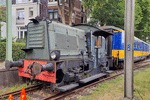 20220715-SpM-NS311.jpg (147733 bytes)
20220715-SpM-NS311.jpg (147733 bytes)|
The Railfaneurope.net Picture Gallery
Directory: /pix/nl/museum/NSM/diesel/200
Last update: Mon 23 Sep 10:51:55 BST 2024
|
|
The Railway Museum (Dutch: Het Spoorwegmuseum) in Utrecht is the Dutch National Railway Museum.
It was established in 1927 and since 1954 has been housed in the former Maliebaan station. The museum currently owns a large and varied collection of rolling stock.
Diesel-Hydraulic shunter NS 311 preserved at the Het Spoorwegmuseum / Railway Museum in Utecht Maliebaan former Station. July 15th, 2022.
In the crisis years of the last century, NS started an important modernization of the freight service. New locomotives were purchased for shunting at the somewhat larger stations, which would form a much improved version of the series 103 - 152, the diesel-electric locomotives 201 - 212. The diesel engine had become sufficiently reliable and replaced the familiar otto petrol engine. Power and weight were increased. The mechanical transmission was replaced by an electric one, and the maximum speed was increased to 60 km/h, so that light freight trains could also be transported. To this end, the locomotive was provided with a lockable cabin, in which control handles and equipment were also fitted. Instead of an air whistle, there was a whistle that was connected to the exhaust through a valve. When the exhaust whistle was used, a bleating sound was created, which gave rise to the nickname 'goatee'.
Until the 2nd World War, the series was expanded with the numbers 213 - 321.
After the war 12 pieces were permanently missing. However, the many and sometimes heavily damaged locomotives were all repaired. In addition, the series was expanded with numbers 322 - 369.
The choice of the Gebr. Stork & Co-manufactured engines proved to have been good, but around 1960 it became necessary to replace the 75 hp 4-cylinder engines. A new Stork version with 3 cylinders and 85 hp was introduced, which was also equipped as a novelty with cooling by means of . its own fuel. The winter problem of frozen engines was thus solved.
Locomotor 311 was sold to the Koninklijke Zinkwit-Maatschappij in Budel in 1952.
Due to declining freight transport and the necessary reorganisations, the decline started in 1969. Locomotors were sold to private individuals and to the scrap yard. In the end, NS and its successors would no longer have a single locomotive in service in 2007, partly as a result of stricter working conditions requirements. On the other hand, no fewer than 45 of the popular machine have been preserved by museum train organizations, and another 28 have been preserved as monuments by various private individuals.
Although an attempt was made to design a worthy successor, approved by the health and safety, it has remained with a few prototypes. Due to the disappearance of small-scale freight transport, there was no longer a need for it.
The KZM donated locomotive 311 to the Railway Museum in 1987. Due to its stay at the KZM, the locomotive is the only one that has always remained green.
The Railway Museum now has three locomotives: 311, 345 and 362, the latter of which is equipped with a hydraulic telescopic crane.
Photo by Guido Allieri (guido@allieri.com) |
|
The Railway Museum (Dutch: Het Spoorwegmuseum) in Utrecht is the Dutch National Railway Museum.
It was established in 1927 and since 1954 has been housed in the former Maliebaan station. The museum currently owns a large and varied collection of rolling stock.
Diesel-Electric Loco NS 362K equipped with hydraulic telescopic crane, built in 1951 by Werkspoor Amsterdam and now preserved at the Het Spoorwegmuseum / Railway Museum in Utecht Maliebaan former Station. July 15th, 2022.
For a general description of the series 201 - 369, see the statement for locomotive 311 of the Railway Museum.
Since 1960 a number of locomotives were made available to the Road and Works Agency. In 1972 locomotor 360 (still green) was the first to receive a hydraulic telescopic crane, to make it easier to replace heavy parts of points. In the years that followed, 16 more - now painted yellow/grey - received such a facility, including the 362.
Locomotor 362 was allocated to the Struktongroep during a redistribution as a result of the privatization of NS. In 2001 Strukton handed it over to NedTrain, which loaned the LMT to the Railway Museum in 2004.
Photo by Guido Allieri (guido@allieri.com) |
|
Photo by Leon Schrijvers. Leon2711schrijvers@yahoo.co.uk Binary file 311_NSM_4III12.txt matches |
|
Sik (goat) 345 at the NSM railway Museum in Utrecht on 9 March 2014.
Photo by Leon Schrijvers Leon2711schrijvers@yahoo.co.uk |
|
Sik (goat) 345 at the NSM railway Museum in Utrecht on 9 March 2014.
Photo by Leon Schrijvers Leon2711schrijvers@yahoo.co.uk |
|
Sik (goat) 345 at the NSM railway Museum in Utrecht on 9 March 2014.
Photo by Leon Schrijvers Leon2711schrijvers@yahoo.co.uk |
|
Locomotor 311 in it's original livery at the outside yard of the Utrecht Railway Museum.
Photo by W. Schouten (Hertog-Dixi@hotmail.com) |
|
Museum Locomotor Number 345 at Utrecht Railway Museum.
Photo by W. Schouten (Hertog-Dixi@hotmail.com) |
|
NS/National Railway Museum - The Netherlands Open Train Festival at the National Railway Museum in Utrecht. Small diesel shunter "Sik" number 345. Utrecht Maliebaan - 10-04-2023 Photo by Marco van Uden |
| Scan of a picture by Leon Schrijvers Leon2711schrijvers@yahoo.co.uk Binary file Sik_311.txt matches |
|
NS 311 in the yard of the Spoorwegmuseum in Utrecht. 26.07.2005 Photo by Thomas van Berkel |
|
A green shunter (original colors) of type 200/300 standing at Dutch raiway
museum.
Dutch raiway museum (NSM), The netherlands.
Photo taken on 30/5/98 by M.Tieleman (M.Tieleman@caiw.nl) |